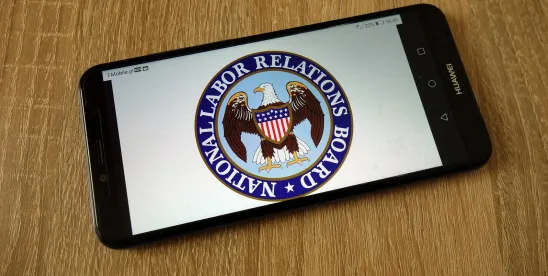On June 13, 2024, the U.S. Supreme Court dealt a blow to the National Labor Relations Board’s (“NLRB” or the “Board”) ability to seek injunctive relief during the pendency of an unfair labor practice proceeding. In a near unanimous decision (Justice Jackson dissented in part but concurred in the judgment), the Court rejected the Board’s argument that injunctive relief under Section 10(j) of the National Labor Relations Act (“NLRA” or the “Act”) requires a lesser showing than the traditional standard for a preliminary injunction.
The Court’s decision comes on the heels of a unanimous decision by the U.S. Court of Appeals for the Second Circuit vacating a Section 10(j) injunction against Amazon.
These recent decisions show that federal courts will not ease the Board’s burden for securing the typically extraordinary remedy of injunctive relief, which could weaken the Board’s remedial power while litigation is ongoing.
The Supreme Court’s Starbucks Decision
In Starbucks Corp. v. McKinney, the NLRB sought a Section 10(j) injunction against Starbucks after the Company terminated several employees in Memphis, Tennessee for violating company policy by inviting local media to cover an ongoing unionization effort. The former employees then filed unfair labor practice charges alleging the terminations were unlawful. The Board petitioned the District Court for the Western District of Tennessee for a temporary injunction under Section 10(j) that would require the reinstatement of the former employees for the duration of the unfair labor practice proceedings.
Section 10(j) of the NLRA authorizes the Board to seek temporary injunctive relief from a federal district court while the merits of an unfair labor practice case are being litigated to ensure that any remedy the Board might eventually issue will not be moot or hollow. In granting a Section 10(j) injunction, some circuits apply the traditional four-factor standard for temporary injunctive relief, meaning the petitioning party must show:
- likelihood of success on the merits,
- irreparable harm without an injunction,
- the balance of equities favors an injunction, and
- that temporary relief is in the public interest.
This four-factor standard is a heavy burden and applies when evaluating most requests for temporary injunctions absent some directive from Congress to the contrary.
However, as we previously discussed, several circuits—including the Second, Fifth, Sixth, and Tenth Circuits—applied a lower standard to temporary injunctions sought under Section 10(j) of the NLRA. Under the lower, two-part standard, the NLRB need only show:
- “reasonable cause” to believe an unfair labor practice occurred, and
- that injunctive relief is “just and proper.”
This two-part standard is far easier for the Board to satisfy because it requires only a showing that the Board’s theory of the underlying unfair labor practice case is “substantial and not frivolous.” By sharp contrast, under the traditional four-factor standard, the Board would have to show that it is “likely” to succeed on the merits of its case. Applying this lower standard, the Board obtained a Section 10(j) injunction against Starbucks, which was affirmed by the Sixth Circuit.
The Supreme Court granted certiorari to resolve the circuit split on this important issue. The Court vacated the injunction and remanded the matter, holding that nothing in the text of the Act indicates that Section 10(j) injunctions should be analyzed under a lower standard. The Court pointed to provisions of other laws where Congress expressly incorporated language to inform the standard that should apply to equitable relief (like an injunction) under the particular statute. The Court observed that the NLRA itself includes such language that requires a higher standard for injunctions against strikes and lockouts. In the absence of any such language in Section 10(j), the Court held that the traditional four-factor standard for a temporary injunction must apply.
Amazon’s Success in the Second Circuit
Just one day earlier, in a unanimous decision by a three-judge panel, the U.S. Court of Appeals for the Second Circuit vacated an injunction levied against Amazon pursuant to Section 10(j). The Second Circuit’s decision tossed the cease-and-desist order imposed by the District Court for the Eastern District of New York, which required the company to refrain from activity that violates the Act. As we previously discussed, in November 2018, Judge Diane Gujarati partially granted a 10(j) injunction against Amazon after it fired an employee based on an alleged verbal altercation between him and a co-worker and the former employee filed an unfair labor practice charge, claiming that he was fired as a result of his union organizing activity.
While the unfair labor practice was pending, the Board petitioned the Eastern District for a Section 10(j) injunction against Amazon. Judge Gujarati, applying the lower two-part standard, held that the evidence “amply support[ed]” the Board’s position that the employee was discharged in violation of the Act and, therefore, partially granted the injunction, requiring Amazon to cease and desist from the alleged unlawful activity. Amazon appealed, and the Second Circuit sided with the Employer and vacated the injunction. The Second Circuit held that Judge Gujarati abused her discretion in issuing the order by failing to adequately explain how the cease-and-desist order would protect the status quo or prevent irreparable harm under the “just and proper” analysis.
Amazon prevailed under the two-factor standard that the Second Circuit previously applied before Starbucks, but now, a court analyzing the merits of a Section 10(j) injunction must consider the four-factor test that traditionally applies to preliminary injunctions in federal court.
Takeaways
Section 10(j) injunctions have become a favored tactic of the NLRB General Counsel and the Regions which she oversees, particularly in the high-profile organizing campaigns that have hit companies like Starbucks and Amazon. As we discussed in our February 2022 blog post, NLRB General Counsel Jennifer Abruzzo announced that it was a key initiative of hers to encourage Regional Directors to seek injunctive relief under Section 10(j).
The Supreme Court’s decision in Starbucks reaffirms a heightened burden for injunctive relief under Section 10(j) uniformly across all circuits. This effectively makes it more difficult for the NLRB to secure such injunctions during the pendency of an unfair labor practice proceeding and deals a blow to one of General Counsel Abruzzo’s major policy initiatives. However, even before the Starbucks decision, the Second Circuit’s ruling in Amazon indicates that federal courts—including those which previously applied the lesser standard—are unwilling to issue an injunction pursuant to Section 10(j) unless supported by a detailed and well-explained rationale.
Although employers can anticipate that the NLRB will continue to seek injunctive relief under Section 10(j) pursuant to the General Counsel’s well-publicized initiative, the heightened standard and increased scrutiny will ensure that such injunctions remain the “extraordinary” remedy Congress intended them to be.




 />i
/>i

